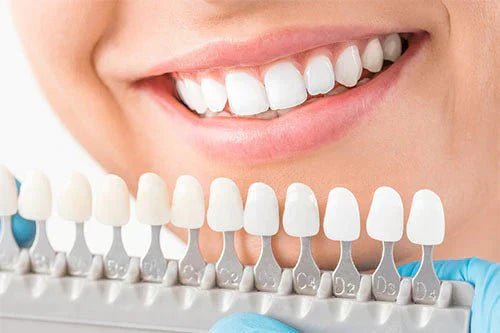Got Damaged Veneers – Here’s What You Need to Know
While veneers like porcelain or composite are designed to withstand significant force, they’re more brittle than natural teeth and aren’t impervious to breaking or chipping. Accidents or teeth grinding can cause cracks, thus requiring immediate fixing or, worse, replacement.
But no matter how small or big the damage is, you shouldn’t attempt to fix your veneers alone.
Whether composite or porcelain, veneers are delicate dental appliances that require professional care.
Attempting to repair or adjust veneers without the proper expertise can lead to further damage or complications.
In such cases, the best and most appropriate action is to visit your local dentist and evaluate your veneers. From that point, your dentist can tell you whether it can be repaired using dental resin or an entire veneer replacement is recommended.
Nonetheless, here’s everything you need to know about repairing veneers.

Reasons why veneers chip or break
Numerous studies on dental veneers, specifically porcelain, have indicated success rates ranging from 53% to 94.4%.
Approximately 5 to 9 out of 10 patients have fully functional veneers during their lifespan. But then again, while veneers are known for their success, like many other dental treatments, they can also sometimes fail.
The likelihood of failure or breaking depends on the type of veneers you have and how well you maintain them.
For instance, composite veneers can last up to 5 to 8 years, a substantially shorter lifespan than a set of porcelain veneers, which typically last at least 10 or 15 years.
However, composite veneers might require replacement one or two years earlier than expected without proper care.
As to the most prevalent causes of veneer damage, documented reports and patient feedback suggest:
Improper design or placement
When veneers are not meticulously designed to conform to the individual tooth's unique characteristics or are not placed precisely, it compromises their structural integrity. This can be compared to balancing a plate on your fingertip. If the balance is not optimal, the vessel may fall and break.
Therefore, proper design and precise placement are critical for ensuring the long-term success and durability of dental veneers. And finding a reliable and experienced cosmetic dentist can play a significant role in this process.
Persistent teeth grinding or clenching (Bruxism)
Bruxism, characterized by the habitual grinding or clenching of teeth, exerts continuous and excessive forces on dental veneers.
Individuals with bruxism are prone to veneer damage because the forces generated during grinding or clenching can exceed the materials' resilience.
Biting into hard foods or objects
Biting forcefully into hard substances, such as ice or candies, subjects the veneers to intense pressure. Over time, this can result in stress or complete fractures within the veneer material. These veneers may not withstand the shear forces generated by such activities.
Sudden blows or impacts
Epidemiological research suggests an approximate global annual occurrence of dental trauma of around 4.5%.
If the US has an adult population of 260,836,730, it means around 11,711,657 adults within this population may experience dental trauma each year.
Much like a glass window shattering upon impact, dental veneers may suffer from fractures or detachment from the teeth during accidents or trauma, including sports-related injuries.
While designed for everyday use, dental veneers may not possess the resilience necessary to withstand abrupt and significant forces.
Signs your veneers are damaged
Though damaged veneers are often unmistakable, some issues might not appear as cracks or lines. Tell-tale signs can be a form of stains, tooth sensitivity, and pain.
If the veneer's surface becomes worn or damaged, it can become more porous, making it susceptible to staining. This may happen over time due to normal wear and tear or abrasive toothbrushing and consuming too much coffee and tobacco.
If decay or leakage occurs at the interface between the natural tooth and the veneer, it can also result in discoloration. This may indicate a more significant issue with the veneer that requires professional attention.
Similarly, pain and sensitivity often accompany damaged veneers, particularly when some cracks or chips expose the underlying tooth structure. In such cases, your tooth becomes more susceptible to temperature variations, like the discomfort caused by hot or cold foods and beverages.
Risks and complications of damaged or chipped veneers
Just as damaged or broken personal appliances have inherent risks, the same principle applies to dental veneers. It goes without saying that damaged or chipped veneers are never safe and may cause serious aesthetic and oral health issues. Some of these risks include:
Aesthetic problems
When a veneer is chipped or damaged, it can create an uneven and unsightly appearance or visible imperfections. This can be particularly concerning since veneers are often used for cosmetic purposes.
Damaged veneers may also become more susceptible to staining, compromising their appearance over time.
Functional problems
A damaged veneer may result in discomfort or difficulty when biting or chewing. This can impact one's ability to enjoy food and maintain a healthy diet.
For instance, improper chewing of food can lead to the introduction of larger particles into the digestive system, potentially resulting in digestive issues such as gas, abdominal swelling, constipation, adverse food reactions, headaches, and diminished energy levels.
Sometimes, a chipped veneer can affect speech, causing lisping or difficulty pronouncing certain words.
Oral health problems
Again, it's not just about looks – there's a whole bunch of potential oral health issues you might run into:
For example, your natural teeth under those veneers become exposed. Exposing the natural teeth might also lead to tooth root exposure. If this happens, the cementum, which covers the dentin and nerve pulp, can quickly decay or wear away, causing sensitivity.
Those exposed teeth can also get cavities without their protective covers. Allowing cavities to thrive means more money spent at the dentist and potentially even losing a tooth. In the worst-case scenario, you might have to say goodbye to a tooth if it's too damaged.
Damaged veneers can mess with your gums, too. They might not fit right, which can create pockets for bacteria, possibly leading to gum issues.
Options for repairing damaged or chipped veneers
Typically, in cases of severe fracture or damage to a porcelain veneer, the recommended solution is to replace it. This involves the dentist removing the damaged veneer, taking a new impression, and sending it to a lab for a new one to be crafted. Once the new veneer is ready, it is placed on the tooth.
Alternatively, your dentist might use different procedures to repair your veneers. The choice of procedure depends on factors such as the damage type, materials on hand, cost, and the preferences and skills of the dentist or the person doing the repair.
Here are some general guidelines:
Reattaching a veneer that has fallen off
When a veneer comes off intact, and both the veneer and the tooth are in good shape, it's possible to reattach it.
This option is often quicker and more cost-effective than crafting a new veneer. However, it might have a different longevity or natural appearance. The dentist must remove the old bonding material, prepare the veneer and the tooth again, and then apply a fresh bonding agent to reattach it.
Pros
- Cost-Effective - usually less expensive.
- Quick - faster than crafting a new veneer.
- Minimal Disruption - preserves the existing veneer's structure.
Cons
- Durability – it may not last as long.
- Aesthetics - might look less natural.
- Preparation -requires the removal of old bonding material and reconditioning of the veneer and tooth
Shattered veneers
In cases where a veneer has shattered into pieces, or if reattachment isn't a practical or desired solution, crafting a new veneer becomes necessary.
Pros:
- Durability - offers better longevity
- Aesthetics - provides a more natural appearance
- Customization - can match the original veneer
Cons
- Cost - generally more expensive
- Time-consuming - involves taking new impressions, lab fabrication, and bonding. It may involve removing the old veneer if reattachment isn't feasible or desirable.
Patching
When dealing with a minor crack or chip in a veneer, patching is feasible if the damage is minimal and doesn't impact the veneer's function or appearance.
Pros
- Cost-Effective
- Faster than making a new veneer
Cons
- Aesthetics - may not perfectly match the original in color or texture.
- Limited applicability - suitable only for minimal and non-critical damage.
Polishing minor chips
It’s possible to perform a polishing procedure, provided the chip is exceedingly small and has no bearing on the veneer's function or look. To carry out this process, the dentist will employ a fine-grit abrasive tool to smooth the chip and polish the veneer's surface.
Pros
- Economical
- Quick
- Minimal Alteration - maintains the overall structure.
Cons
- Altered appearance - may slightly change the veneer's shape or length.
- Limited applicability - appropriate for minor, non-critical issues.
To make the best choice for your situation, it's essential to thoroughly consider these aspects, considering the trade-offs involving cost, time, aesthetics, and how long the fix will last. This thoughtful analysis will help you arrive at the right decision for your veneer repair needs.
Also, your dentist's expertise will be invaluable in guiding you toward the right decision for your veneer repair.
Consult a cosmetic dentist in Culver City
It's crucial to recognize that your veneers, while resilient, can still be prone to damage. Understanding the causes, potential risks, and the range of repair options available is essential for maintaining a healthy and confident smile.
We strongly advise consulting with a knowledgeable dentist to make the most informed choice. Their expertise will help you consider your budget, expectations, and the advantages and disadvantages of each repair option.
For personalized advice and professional veneer repair, don't hesitate to schedule an appointment with our skilled cosmetic dentist at United Dental Care, Culver City, CA. You can visit our website for additional information or book a free consultation.
Your beautiful and confident smile is well within reach with United Dental Care!
Got no insurance? Our patients don’t need it!
With our Preventive Care Membership, you'll save at least $514 a year on essential dental care. For just $39.00 per month and a one-time $99 Lifetime Activation Fee, you'll enjoy top-tier preventive treatments and more at unbeatable prices and discounts.
Here’s the good news: there are no maximums, no deductibles, and no waiting period, ensuring your dental health is both affordable and accessible. Don't miss out. Join us today for a healthier smile!




 By:
By: 


